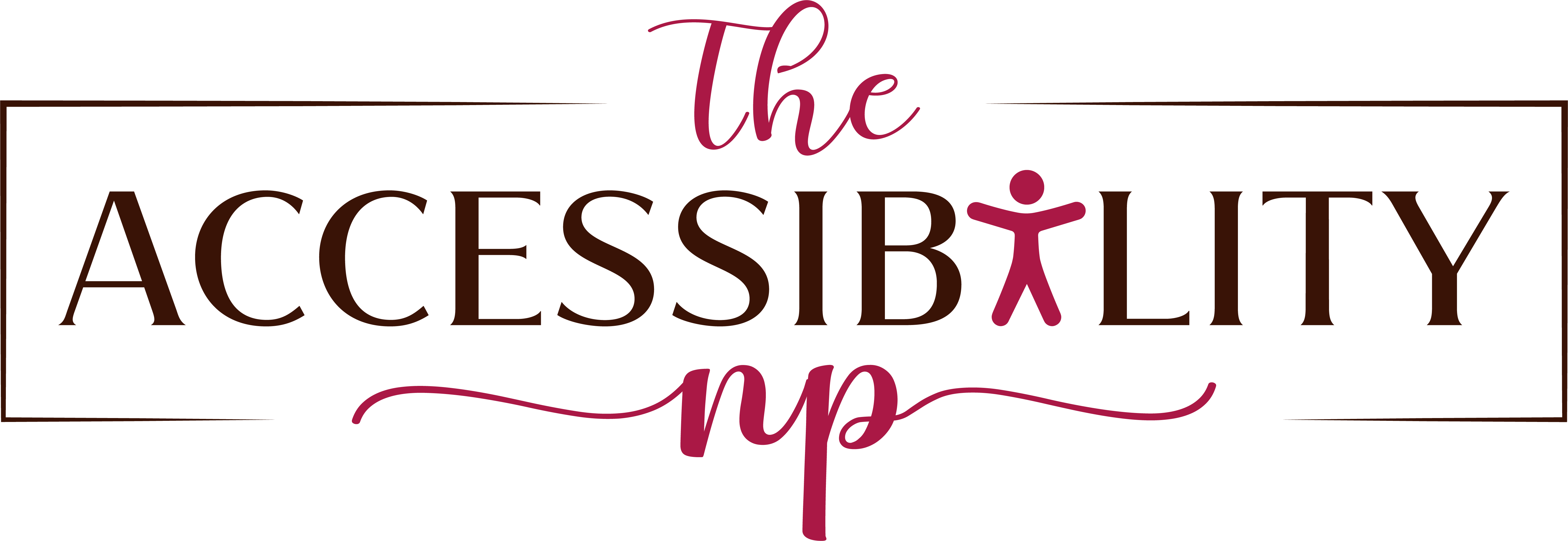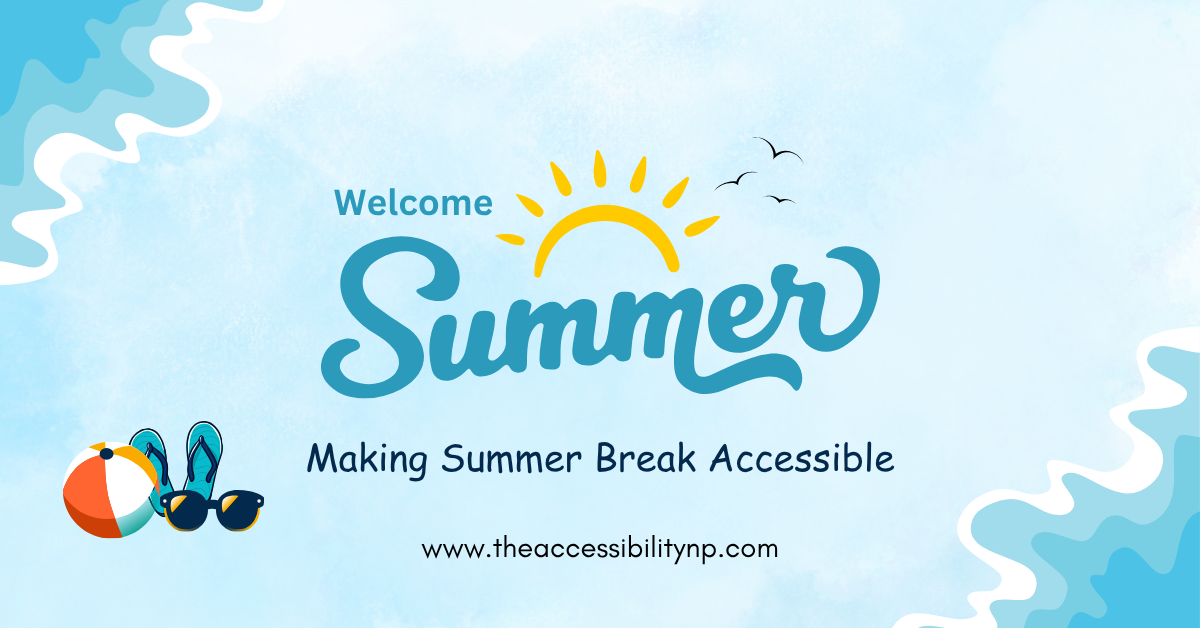Summer break should be a time of joy—but if you’re raising a disabled child or teen, you know it also brings a new set of responsibilities, decisions, and barriers. That doesn’t mean we don’t love summer—it just means we experience it differently. And that difference deserves to be seen, understood, and supported.
In our home, the start of summer doesn’t feel like a break. It feels like a shift. And while that shift brings more sunshine and less paperwork, it also brings transitions, loss of structure, and a patchwork of services we’re expected to manage ourselves. Whether you’re new to navigating summer or this isn’t your first time juggling extended school years, respite gaps, or inconsistent therapies—this post is for you. Let’s talk about what accessibility looks like when school is out and life keeps going.
When routine disappears overnight
For many disabled children and teens, the school year offers not only education but consistency. Para support, therapy, peer interaction, sensory-friendly classrooms, and accessible transportation are often built into their daily routine. When summer begins, all of that can vanish. What’s left is a gaping routine gap that can be incredibly destabilizing—for the child, and for us as caregivers. The problem isn’t just the lack of structured activities; it’s the loss of predictability. For many of our children, predictability is not a preference—it’s a lifeline.
Without it, we often see more meltdowns, less sleep, increased anxiety, and moments of self-injury or aggression that haven’t surfaced in months. In our house, that first week without school always takes some recalibrating. We’ve learned to prioritize rhythm over routine—focusing on predictability without creating rigid schedules that add to everyone’s stress.
Creating rhythm, not rigid schedules
We keep things simple: a visual schedule taped to the wall with painter’s tape and printed icons. There’s no fancy laminating or color-coding. It includes wake-up, meals, sensory time, outside time, rest time, and whatever else we know will help the day feel less open-ended.
Timers are our secret weapon. They help my daughter transition between activities, especially when going from something she loves to something less preferred. I give her a five-minute warning and show her the countdown visually or on her iPad. Even if she doesn’t like the transition, she’s prepared—and that changes everything.
To keep things from feeling monotonous, we anchor each day with one predictable event. Monday might be library day. Friday is movie and takeout night. Wednesday could be her OT telehealth session followed by a special snack. It doesn’t have to be big. In fact, smaller works better. What matters is that there’s something she can anticipate, something we can talk about using her AAC, something we both can look forward to.
Redefining what summer learning looks like
People often ask, “What will she do all day?” It’s a well-meaning question, but the answer is layered. She’ll stim. She’ll nap. She’ll use her AAC to tell us she’s hungry. She’ll ask to watch the same show for the seventh time. She’ll practice daily living skills by helping carry laundry to the washroom. She’ll play in her sensory bin and water the plants. And through all of that—she’ll be learning.
Because learning doesn’t stop when school stops. It just shifts shape. We don’t need a full academic curriculum to keep our children growing. What they need most is connection, security, and room to explore the world around them. And yes—sometimes that world is just the living room. But it still counts.
Making joy accessible at home
If formal summer programming or camps aren’t accessible to you—either because they’re not inclusive, too expensive, undertrained, or just don’t exist in your area—you’re not alone. We’ve tried camps where no one was trained in AAC. We’ve been told our child would need to “bring their own 1:1 support,” even when the program claimed to be inclusive. So we’ve learned to build summer joy in small ways, right where we are.
Some of our favorite activities aren’t big or expensive. Sensory bins filled with dry rice, sand, or water beads turn into whole afternoons of tactile play. We use cookie sheets as trays, throw down an old towel, and give her scoops and spoons to explore. Sometimes we add frozen toys and let her work them free—fine motor skills, sensory regulation, and joy all in one.
When we need movement, we do scavenger hunts around the house or yard using pictures instead of words. We’ve turned sorting laundry into a game. We’ve created sticker charts just for completing “pick-up routines,” not as a reward system but as a way to offer visible feedback she understands. For us, art happens outside. We hang a big piece of paper on the fence and let her go wild with rollers and paint. If that’s not possible, chalk on the driveway or sponge painting in a plastic bin indoors works just as well.
Therapy changes—but support doesn’t have to
Therapies also shift during summer. School-based services end, and private ones often go on modified schedules. There have been summers where we’ve lost therapy altogether—and I panicked. But then I realized that therapy is everywhere. It’s in pretend play, where she practices speech goals. It’s in the garden, where she works on fine motor skills. It’s in the daily routines where she’s supported to do more independently.
And most importantly, rest matters. We don’t talk about that enough. Disabled children and teens need rest. We ask a lot of them—therapies, transitions, navigating inaccessible spaces—and they’re often exhausted. So when therapy pauses, it can also be a chance to reset.
Keep AAC active in everyday moments
AAC use doesn’t stop in the summer either. If your child uses AAC, bring it into everything. Model words during snack time, pool play, even quiet car rides. Add vocabulary like “hot,” “go,” “outside,” “again,” and “all done.” Make it part of their summer world so that communication stays consistent and supported.
Travel doesn’t define your summer
For some families, the idea of getting on a plane, booking an Airbnb, or even staying overnight with relatives feels impossible. Medical equipment, toileting needs, sensory meltdowns, wandering risks, and feeding issues make traveling with our children a huge feat. For many of us, summer doesn’t include vacations. It includes managing home without school as a buffer. And that’s okay.
We’ve created our own summer “getaways” by turning everyday experiences into adventures. A 10-minute train ride. A splash pad at an empty park. A scenic drive to the farm stand. We pack snacks, bring visuals, set expectations, and allow ourselves to leave early if needed. The success of an outing isn’t measured by how long we stayed—it’s measured by how supported our child felt during the experience.
You’re tired for a reason
Caregiver fatigue peaks in the summer. You’re not imagining it. With fewer breaks, less structured support, and higher expectations to “make memories,” it’s no wonder many of us feel stretched to our limits. When you’re the full-time parent, therapist, cook, advocate, and activity planner, it’s easy to lose track of yourself.
That’s why micro-moments of care matter. I take my coffee outside, even if it’s just for five minutes. I listen to music while folding laundry. I ask for help—even when it’s awkward. I write a list of three things I need support with and put it on the fridge. When someone says, “Is there anything I can do?”—I point to the list.
Supports look different in the summer
Summer supports may not come in the form of a respite worker or full-time caregiver. They might look like a neighbor who brings dinner. A friend who sits with your child while you shower. A therapist who sends you ideas via email even when they’re off for the season. Accept what’s offered.
Create a basic care plan—a single sheet with your child’s routines, meds, and needs—and keep copies ready for when help is available. Being prepared makes it easier to say yes.
Access isn’t a school-year benefit
When school staff and therapists return in the fall, I want them to remember: accessibility doesn’t end when school lets out. It should extend into the community. Our families deserve parks with adaptive swings, museums with sensory rooms, libraries with visual schedules, and summer programs that don’t just tolerate disability but plan for it.
We need more than ADA ramps. We need understanding. We need training. We need true inclusion.
Something to carry into the week
Your child doesn’t need Pinterest-perfect crafts or daily outings. They need you. Your steady presence. Your care. Your flexibility. Your understanding of how they communicate, what soothes them, what excites them, what helps them feel safe.
This summer, let’s stop measuring success by how much we fit in—and start measuring it by how much we slow down and tune in. Let’s create space for rest, for joy, for connection, and for a kind of learning that can’t be captured in worksheets.
Accessibility isn’t a season. It’s a right. And this summer, we’re going to keep showing what that looks like—one supported, sensory-friendly, fully loved day at a time.
Stay tuned for next week’s post where we’ll dive into ways to keep using assistive technology through the summer, even outside of the classroom. Until then, take a breath. Take a break. Take your time. You’ve got this.

